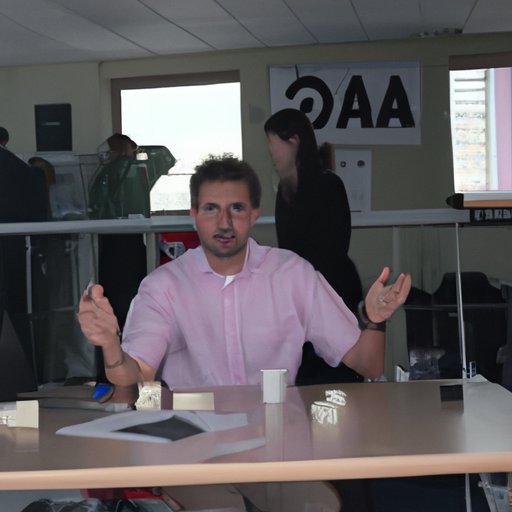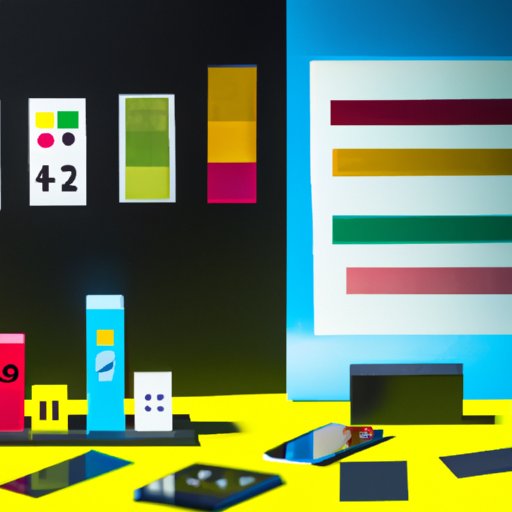I. Introduction
Creativity is known as a powerful tool in solving everyday problems and bringing new ideas to life. However, many people struggle with creativity due to various reasons, such as lack of inspiration, fear of failure, and a lack of knowledge on how to train creativity. Therefore, in this article, we provide 7 practical ideas to train creativity by exploring exercises, embracing playfulness, overcoming creative blocks, utilizing limitations, finding inspiration through historic works of art, exploring new forms of media, and understanding the stages of the creative process.
II. Think Outside the Box: 5 Exercises to Push Your Creative Limits
Exercising is not only good for physical health but also for training creativity. By setting challenges and attempting new approaches, your brain will be stimulated to think out of the box more often. Here are 5 exercises that can push your creative limits:
a. Brainstorming Sessions
Brainstorming sessions are one of the most common exercises for creativity. By setting a theme or problem, and trying to generate as many ideas as possible, without any judgment, one can open new paths of thinking. To start, set a timer for 5-10 minutes, with a clear theme or problem. Write down every single idea that comes to your mind and do not judge or analyze them until later. When the time is up, evaluate the ideas, and try to narrow them down to one or two best ones to develop further.
b. Freewriting
A common exercise in creative writing classes is freewriting. The goal is to allow your mind to write freely, without thinking about grammar, topic coherence, or even sensibility. Set a timer for 10 to 15 minutes, grab a pen and paper, and let your mind write everything that comes to it. Do not lift your pen from the paper and do not stop writing at any point. When the time is up, read what you have written, pick one sentence that stands out, and start developing it into a new idea.
c. Observation Exercises
The world around us provides a vast range of opportunities for inspiration. Observing in detail can help us find new possibilities, ideas, and unique points of view. To start an observation exercise, select an object, or a scene, and observe it for at least 5-10 minutes. Write down every detail that you find, including colors, shapes, textures, and patterns. After the observation time is up, think of how you can apply the details to new contexts, and generate a new idea.
d. Mind Mapping
Mind mapping is an effective tool to connect and organize ideas visually. It can help you generate an initial idea and develop it further. To start, write down a central word that describes the theme of your idea in the center of a page. Then, draw branches that radiate out from the center, each representing a new idea or category. Keep adding new branches until all avenues of the topic, or problem, have been explored.
e. SCAMPER Technique
The SCAMPER technique is an acronym that stands for substitute, combine, adapt, modify, put to another use, eliminate, or reverse. It provides a structured process for generating new solutions to a problem by applying different perspectives and changes to the current idea. To use the SCAMPER technique, pick an existing idea or product, and apply each of the 7 aspects of the acronym to it, generating new and diverse ideas.
III. Embrace Your Inner Child: How Play Can Fuel Creativity
Playfulness is often associated with children, however, it can be a powerful tool for adults to boost their creativity. By engaging with activities that are meaningful and enjoyable, one can overcome rigid thinking and embrace new perspectives. Here are some creative activities that can be done at any age:
a. Doodling
Doodling is a simple way to engage with free-form imagery without the pressure of producing finished artwork. Grab a pen and a piece of paper, and start drawing whatever comes to your mind, without any judgment or goal. Let your hand dictate the shapes, and observe how they evolve.
b. Playing with Clay
Clay is a tactile and versatile material that can be used to create shapes, forms, and textures. By engaging in a playful way with clay, one can explore new ways of expressing, combining, or transforming ideas. Sculpting figures that represent metaphors, or molding shapes for the further development of mind maps can be some of the exercises to practice.
c. Creating a Collage
A collage is an assemblage of materials such as newspapers, magazines, photographs, and drawings. Creating a collage involves selecting, cutting, and arranging the materials in a meaningful composition. By combining different materials, one can create new meanings, analogies, and even new characters. It can also be a way to explore different forms of communication and identity.
d. Improvising a Story
Improvising a story is an open-ended activity that can further develop one’s creative thinking and verbal skills. The goal is to start from a single word or phrase, and continue building the story on the fly. By adding new characters, conflicts, and settings, one can practice creating diverse connections and narratives.

IV. Breaking Free from Creative Blocks: Tips and Strategies
Creativity is not always a smooth process, and sometimes one may encounter barriers that prevent them from generating new ideas. These blocks can be due to fear of failure, self-doubt, or even the lack of resources. Here are some tips and strategies to overcome the blocks and keep the creativity flowing:
a. Incremental Progress
An overwhelming task can sometimes hinder creativity. To overcome this, break the task into smaller, manageable ones by setting achievable goals and milestones. Smaller successes can build the momentum and confidence needed to tackle bigger tasks.
b. Setting Small Goals
Setting achievable and measurable goals can help one stay focused and accountable. The goals do not necessarily have to be related to a specific project, but they should challenge and motivate to push the limits of creativity and skill.
c. Collaboration
Collaboration can offer new perspectives and feedback on ideas. Working with someone or a group that shares the same goals and interests can provide different skills, connections, and experiences.
d. Mindfulness Techniques
Mindfulness is a state of non-judgmental awareness of the present moment. Practicing mindfulness can help overcome negative thoughts and emotions that block creativity. Techniques such as deep breathing, visualization, and meditation can help concentration, reduce stress, and increase focus on the task at hand.
V. The Power of Limitations: How Constraints Can Boost Creativity
Limitations may seem restrictive, but they can boost creativity by providing focus and challenging the imagination. Here are some common types of limitations that can be utilized:
a. Time
A limited amount of time can force one to think efficiently and prioritize ideas. To incorporate a time limitation to an exercise, set a timeline and try to generate as many ideas as possible before the time is up.
b. Resources
A limited amount of resources can encourage one to find creative ways to use what is available. To incorporate a resource limitation to an exercise, select a few materials, and try to generate ideas by exploring the possibilities of different combinations.
c. Themes
A given theme can focus one’s ideas and challenge their imagination. To incorporate a theme limitation to an exercise, set a problem or a theme that needs to be explored, and try to generate ideas that relate to the theme.
VI. Looking to the Past: How Historical Works of Art Can Inspire New Creations
Historical works of art can be a rich source of inspiration for new creations. Understanding how previous artists approached certain themes or constraints can provide insight and new perspectives. Here’s how to do it:
a. Finding a Source of Inspiration
Look for an artwork that interests and challenges you, and try to understand its context, theme, and techniques. It can be a painting, sculpture, or even a tapestry.
b. Analyzing the Work
Examine the details of the work, and try to understand how the artist approached the idea, what elements compose it, and how it fits with the rest of the artist’s body of work. Note down your observations and reflections.
c. Applying to New Context
Try to apply the observations and reflections to a new context, such as a new theme, material, or medium. Generate ideas that incorporate the learned techniques, shape, or style.
VII. Diversify Your Inspiration: Exploring New Forms of Media for Creativity
Mixed media, also known as multimedia, incorporates more than one form of media, from visual to auditory, physical to digital. Diversifying the inspiration sources can help one create more complex and nuanced ideas. Here are some examples of media:
a. Movies
Movies can offer a rich source of inspiration, from the narrative to the visual effects. Watching a movie with a specific theme might inspire an idea or a new perspective that can be utilized in a new project.
b. TV Shows
TV shows offer an opportunity to explore different genres and styles. By following a series that interests you, you can become acquainted with the characters and the plot, and imagine new stories that could follow.
c. Books
Books can give a deeper understanding of different topics, from a personal to a worldwide scale. By finding titles that resonate with your interest areas, you can expand your knowledge and use the learned information as a creative catalyst.
d. Music
Music has the power to stir up emotions and set the mood for different activities. By exploring different genres, themes, and rhythms, you can set the atmosphere for a productive and creative session.
e. Social Media
Social media platforms, such as Instagram, Pinterest, or Youtube, have become a huge source of inspiration through the diverse content that is available. By following accounts that interest you, you can explore new styles, techniques, and ideas that other practitioners have shared.
VIII. The Creative Process: How to Find Your Flow and Stay Inspired
The creative process can be seen in four stages: preparation, incubation, illumination, and verification. Understanding the stages and their dynamics can help one stay motivated and focused on the process. Here are some tips for each stage:
a. Preparation
The preparation stage is the phase where one gathers information, dives deep into the topic, and sets the foundation for the creativity that is to follow. To prepare, one can gather different resources on the topic, explore different mediums and techniques, and collect different ideas and inspirations.
b. Incubation
The incubation stage is where one lets the research and information sink in and organizes them in a meaningful way. To incubate, one can take a break from the initial research and do something else that distracts the mind, such as going for a walk, exercising, or engaging in any hobbies. During this phase, ideas may come forth naturally, as the subconscious mind works to connect different pieces of information.
(Note: Is this article not meeting your expectations? Do you have knowledge or insights to share? Unlock new opportunities and expand your reach by joining our authors team. Click Registration to join us and share your expertise with our readers.)
